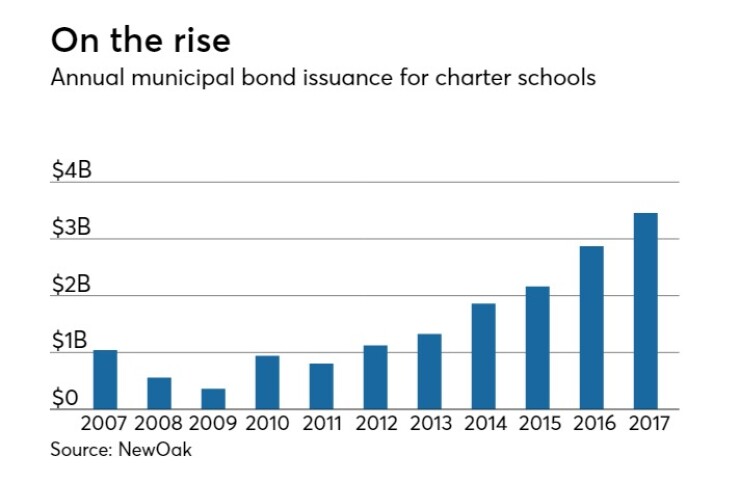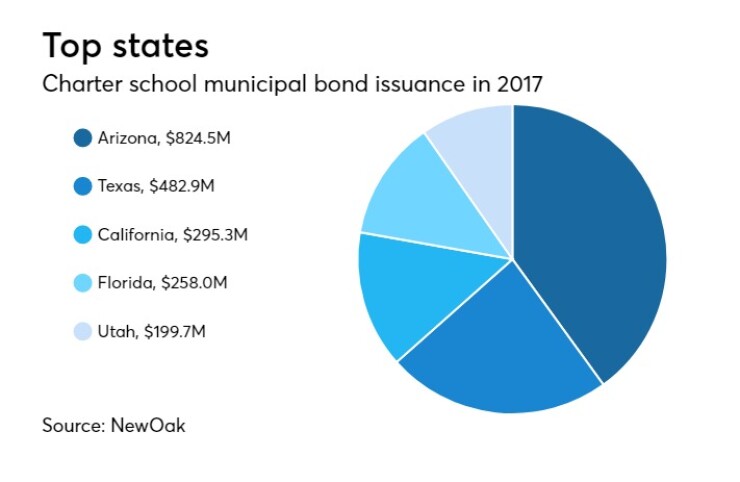A foundation with a philanthropic vision is combining forces with impact investors to provide charter schools with alternative low-cost financing options for building and renovating schools.
The Walton Family Foundation, based in Bentonville, Ark., provided seed funding to create two “innovative” educational facility financing vehicles that it said would provide charter schools with new long- and short-term financing choices, in part because some schools don’t have access to public financing.

With $200 million from the foundation to start up, the
It will also offer impact investors a forum to support high-quality charter schools, and will eventually tap into the bond market, according to Chief Executive Officer Anand Kesavan.
The
“Funds like Walton’s will help charter schools send more resources directly to students and teachers, and work toward the day when more private, public, and philanthropic dollars lead to a level playing field for charter facilities,” said Walton K-12 Education Program Director Marc Sternberg.
Charter schools - public schools that are independently run - serve more than 3.2 million students in 44 states and the District of Columbia.
Surveys suggest there are an additional 2.5 million students whose parents would enroll them in a charter school if location and capacity were not problematic, according to “Strengthening Federal Investment in Charter School Facilities,”
“Access to facilities is and will continue to be a challenge to the growth of the sector,” the report said. “Public charter schools do not have access to the same financing structures as [traditional] district schools.”
The report said 15% of every dollar spent by charter schools goes to facilities or facility-related costs.
It also estimates that the interest rate for charter school borrowing is two times higher than it is for traditional public schools.
Charter school advocates say that less than half of all states authorizing them provide a per-pupil monetary allowance for their facilities, and that opportunities to share space with district schools are rare.
Charter school access to the municipal bond market is also on the rise across the country.

With two decades of tax-exempt bond financing activity on the books, the charter school sector continues to mature with “healthy increases” in the number of transactions and par-amount sold annually, NewOak director and senior analyst Wendy Berry said in a 2017 Year in Review released Feb. 20.
Charter school tax-exempt bond volume in 2017 totaled $3.5 billion, representing the sixth consecutive year of record issuance, said Berry, who specializes in covering the charter sector.
“This volume figure represents a robust increase of more than 20% in par-amount issued over 2016 statistics,” she said, adding that a “substantial amount” of the increase was fueled by the proposed elimination of private activity bonds in early versions of the federal Tax Cuts and Jobs Act.
Although the
Given the solid growth rate in the number of charter schools, along with the expansion of many high-performing schools, she said it is not surprising that more charter schools are accessing the tax-exempt bond market.
“Although charter school bond issuance represents a relatively small piece of overall tax-exempt issuance - still less than 1% of annual municipal volume - it continues to grow at a very healthy pace,” she said.
Charter schools in 22 states and the District of Columbia entered the bond market in 2017, Berry’s year-end review found, though the number of transactions and the par amount associated with each jurisdiction varied widely.
On a combined basis, the top five issuing states were responsible for 54.6% of the number of transactions as well as 59.5% of the total par sold in 2017.
Arizona topped the list with $824.5 million of bonds issued in 27 transactions.
Texas came in second with sales of $482.9 million and California was third with $295.3 million, followed by Florida with $258 million and Utah with $199.7 million.
Because some charter schools don’t have access to the bond market, advocates contend that’s why there’s a need for alternative low-cost financing, a void that the Walton Family Foundation’s initiatives can help fill.
Kesavan said interest from prospective borrowers has been strong since the Charter Impact Fund was announced in April.
“We are in the underwriting process with several borrowers and expect to announce our first round of loans in late summer,” Kesavan said. “Interest from schools has considerably exceeded what our initial capital can fund, which tells us that we should bring more impact investors into the opportunity to help high-quality charter schools serve more students and families.”

The structure of the CIF, Kesavan said, is modeled after successful state revolving funds that serve projects in other sectors, such as clean water and affordable housing.
Over time, the CIF plans to expand lending activity with the objective of tapping the tax-exempt bond market with a structure that will preserve lower-cost financing for school facilities while offering impact investors an attractive option to put capital to work in the sector.
The “CIF is the first pooled fund of its kind for public charter schools, providing permanent, credit-enhanced loans at low cost,” Kesavan said.
Loans will offer charter schools funding for a project from a single source, freeing them from spending significant resources securing multiple streams of private funding. There will be no fees associated with issuance, and no debt service reserve costs.
Generally, loans will be guaranteed by the borrower's credit, net revenues and real property.
“Chief among our eligibility criteria is the charter school's academic standing, which must be high, and its sustainability, which we can gauge in part through family demand for seats,” Kesavan said. “The goal, of course, is to finance projects for high-quality, in-demand schools that will operate far into the future.”
The Facilities Investment Fund, created in collaboration with BAML and managed by Civic Builders, said it is actively underwriting several deals with schools across the country.
Charter management organizations -- which run two or more charter schools -- have also shown interest, FIF officials said.
“There continues to be a lot of excitement around the Facilities Investment Fund from charter schools and CMOs that see the program as a solution to many of their facilities funding challenges,” the FIF officials said.
The FIF loans also expect to save charter schools money by providing funds from one source. Interest rates are currently under 5% and there’s no prepayment penalty.
“The philanthropic and private capital blend allows FIF to achieve an interest rate for schools below commercial market levels,” officials said.
FIF loans will be structured with a first-lien position on the property being financed.
Loans can be made in jurisdictions where real assets revert to the district upon charter revocation, depending upon jurisdiction and how the deal is structured.
Both CIF AND FIF initiatives are designed to make it easier and more affordable for public charter schools to build and renovate facilities, according to foundation board member Alice Walton, the daughter of Walmart founder Sam Walton and his wife Helen.
“This effort will allow resources that were spent on facilities to be directed back into the classrooms, back to the teachers and back to where it should be with the students,” she said.





